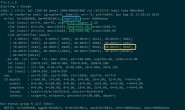中文电子病历命名实体识别(CNER)研究进展
中文电子病历命名实体识别(Chinese Clinical Named Entity Recognition, Chinese-CNER)任务目标是从给定的电子病历纯文本文档中识别并抽取出与医学临床相关的实体提及,并将它们归类到预定义的类别。最近把之前收集整理的一些CNER相关的研究进展放在了github上。主要内容包括Chinese-CNER的相关论文列表,以及目前各个主要数据集上的一些先进结果,希望对CNER感兴趣的读者有所帮助。
github地址:https://github.com/lingluodlut/Chinese-BioNLP
中文电子病历实体识别研究相关论文
在中文电子病历实体识别任务上,已经有不少研究方法被提出,这些研究主要集中在对领域特征的探索上,即在通用领域NER方法的基础上,研究中文汉字特征和电子病历知识特征等来提升模型性能。
综述论文
- 电子病历命名实体识别和实体关系抽取研究综述. 杨锦锋, 于秋滨, 关毅等. 自动化学报, 2014, 40(8):1537-1561.[paper]
- 中文电子病历的命名实体识别研究进展. 杨飞洪,张宇,覃露等.中国数字医学,2020,15(02):9-12. [paper]
- Overview of CCKS 2018 Task 1: Named Entity Recognition in Chinese Electronic Medical Records. Zhang J, Li J, Jiao Z, et al. In China Conference on Knowledge Graph and Semantic Computing, Springer, 2019:158-164. [paper]
- Overview of the CCKS 2019 Knowledge Graph Evaluation Track: Entity, Relation, Event and QA. Han X, Wang Z, Zhang J, et al. arXiv preprint, 2020, arXiv:2003.03875. [paper]
方法论文
- HITSZ_CNER: a hybrid system for entity recognition from Chinese clinical text. Hu J, Shi X, Liu Z, et al. Proceedings of the Evaluation Tasks at the China Conference on Knowledge Graph and Semantic Computing (CCKS 2017), Chendu, China, 2017:1-6. [paper].
- Clinical named entity recognition from Chinese electronic health records via machine learning methods. Zhang Y, Wang X, Hou Z, et al. JMIR medical informatics. 2018;6(4):e50. [paper]
- A BiLSTM-CRF Method to Chinese Electronic Medical Record Named Entity Recognition. Ji B, Liu R, Li S, et al. In Proceedings of the 2018 International Conference on Algorithms, Computing and Artificial Intelligence, 2018:1-6.[paper]
- A multitask bi-directional RNN model for named entity recognition on Chinese electronic medical records. Chowdhury S, Dong X, Qian L, et al. BMC bioinformatics. 2018, 19(17):75-84.[paper]
- A Conditional Random Fields Approach to Clinical Name Entity Recognition. Yang X, Huang W. Proceedings of the Evaluation Tasks at the China Conference on Knowledge Graph and Semantic Computing (CCKS 2018). Tianjin, China, 2018:1-6.[paper]
- DUTIR at the CCKS-2018 Task1: A Neural Network Ensemble Approach for Chinese Clinical Named Entity Recognition. Luo L, Li N, Li S, et al. Proceedings of the Evaluation Tasks at the China Conference on Knowledge Graph and Semantic Computing (CCKS 2018). Tianjin, China, 2018:1-6. [paper]
- Incorporating dictionaries into deep neural networks for the chinese clinical named entity recognition. Wang Q, Zhou Y, Ruan T, et al. Journal of biomedical informatics, 2019, 92: 103133. [paper]
- A hybrid approach for named entity recognition in Chinese electronic medical record. Ji B, Liu R, Li S, et al. BMC medical informatics and decision making. 2019 Apr;19(2):149-58. [paper]
- Chinese Clinical Named Entity Recognition Using Residual Dilated Convolutional Neural Network with Conditional Random Field. Qiu J, Zhou Y, Wang Q, et al. IEEE Transactions on NanoBioscience. 2019, 18(3):306-315. [paper]
- An attention-based deep learning model for clinical named entity recognition of Chinese electronic medical records. Li L, Zhao J, Hou L, et al. BMC medical informatics and decision making. 2019, 19(5):1-1. [paper]
- Chinese clinical named entity recognition with word-level information incorporating dictionaries. Lu N, Zheng J, Wu W, et al. In 2019 International Joint Conference on Neural Networks (IJCNN), 2019,1-8. [paper]
- Fine-tuning BERT for joint entity and relation extraction in Chinese medical text. Xue K, Zhou Y, Ma Z, et al. In 2019 IEEE International Conference on Bioinformatics and Biomedicine (BIBM), 2019, 892-897. [paper]
- Chinese clinical named entity recognition with radical-level feature and self-attention mechanism. Yin M, Mou C, Xiong K, et al. Journal of biomedical informatics. 2019, 98:103289. [paper]
- Adversarial training based lattice LSTM for Chinese clinical named entity recognition. Zhao S, Cai Z, Chen H, et al. Journal of biomedical informatics. 2019, 99:103290. [paper]
- 基于句子级 Lattice-长短记忆神经网络的中文电子病历命名实体识别. 潘璀然, 王青华, 汤步洲等. 第二军医大学学报. 2019,40(05):497-507.[paper]
- 基于BERT与模型融合的医疗命名实体识别. 乔锐,杨笑然,黄文亢. Proceedings of the Evaluation Tasks at the China Conference on Knowledge Graph and Semantic Computing (CCKS 2019) [paper]
- Noisy Label Learning for Chinese Medical Named Entity Recognition Based on Uncertainty Strategy. Li Z, Gan Z, Zhang B, et al. Proceedings of the Evaluation Tasks at the China Conference on Knowledge Graph and Semantic Computing (CCKS 2020) [paper]
- 基于BERT与字形字音特征的医疗命名实体识别. 晏阳天, 赵新宇, 吴贤. Proceedings of the Evaluation Tasks at the China Conference on Knowledge Graph and Semantic Computing (CCKS 2020) [paper]
- Cross domains adversarial learning for Chinese named entity recognition for online medical consultation. Wen G, Chen H, Li H, et al. Journal of Biomedical Informatics. 2020 Dec 1;112:103608. [paper]
- Chinese medical named entity recognition based on multi-granularity semantic dictionary and multimodal tree. Wang C, Wang H, Zhuang H, et al. Journal of Biomedical Informatics. 2020, 111:103583. [paper]
- Chinese Clinical Named Entity Recognition in Electronic Medical Records: Development of a Lattice Long Short-Term Memory Model With Contextualized Character Representations. Li Y, Wang X, Hui L, et al. JMIR Medical Informatics. 2020;8(9):e19848. [paper]
- Chinese clinical named entity recognition with variant neural structures based on BERT methods. Li X, Zhang H, Zhou XH. Journal of biomedical informatics. 2020, 107:103422. [paper]
- 融入语言模型和注意力机制的临床电子病历命名实体识别. 唐国强,高大启,阮彤等. 计算机科学,2020,47(03):211-216.[paper]
- 基于笔画ELMo和多任务学习的中文电子病历命名实体识别研究. 罗凌, 杨志豪, 宋雅文等. 计算机学报, 2020, 43(10): 1943-1957. [paper]
中文电子病历实体识别现存方法性能
中文电子病历实体识别任务的数据集以及相应数据集上系统模型性能表现。目前现存公开的中文电子病历标注数据十分稀缺,为了推动CNER系统在中文临床文本上的表现,中国知识图谱与语义计算大会(China Conference on Knowledge Graph and Semantic Computing, CCKS)在近几年都组织了面向中文电子病历的命名实体识别评测任务,下面我们主要关注CCKS CNER数据集上的结果。
- CCKS 2017
- CCKS 2018
- CCKS 2019
- CCKS 2020
CCKS 2017
CCKS17数据集:原始数据集分为训练集和测试集,其中训练集包括300个医疗记录,人工标注了五类实体(包括症状和体征、检查和检验、疾病和诊断、治疗、身体部位)。测试集包含100个医疗记录。
语料数据统计
症状体征 | 检查检验 | 疾病诊断 | 治疗 | 身体部位 | 总数 | |
训练集 | 7,831 | 9,546 | 722 | 1,048 | 10,719 | 29,866 |
测试集 | 2,311 | 3,143 | 553 | 465 | 3,021 | 9,493 |
现存方法性能比较 (%F值)
方法 | 症状体征 | 检查检验 | 疾病诊断 | 治疗 | 身体部位 | 总体 | 论文 |
HIT-CNER (Hu et al., 2017) Top1 | 96.00 | 94.43 | 78.97 | 81.47 | 87.48 | 91.14 | HITSZ_CNER: a hybrid system for entity recognition from Chinese clinical text |
BiLSTM-CRF-DIC (Wang et al., 2019) | – | – | – | – | – | 91.24 | Incorporating dictionaries into deep neural networks for the chinese clinical named entity recognition |
RD-CNN-CRF (Qiu et al., 2019) | – | – | – | – | – | 91.32 | Chinese Clinical Named Entity Recognition Using Residual Dilated Convolutional Neural Network with Conditional Random Field |
Tang et al. (2019) | – | – | – | – | – | 91.34 | 融入语言模型和注意力机制的临床电子病历命名实体 识别 |
PDET Feature in Model-II (Lu et al., 2019) | – | – | – | – | – | 92.68 | Chinese Clinical Named Entity Recognition with Word-Level Information Incorporating Dictionaries |
BiLSTM-CRF-SP+ELMo (Luo et al., 2020) | 95.37 | 94.94 | 81.13 | 83.32 | 88.74 | 91.75 | 基于笔画ELMo和多任务学习的中文电子病历命名实体识别研究 |
FT-BERT + BiLSTM + CRF+Fea (Li et al., 2020) | 96.57 | 94.09 | 81.26 | 82.62 | 88.37 | 91.60 | Chinese clinical named entity recognition with variant neural structures based on BERT methods |
注:Top表示当时评测的前三名系统方法。
CCKS 2018
CCKS18数据集:原始数据集包括训练集和测试集.其中训练集包括600个医疗记录,人工标注了五 类实体(包括解剖部位、症状描述、独立症状、药物、 手术)。测试集包含400个医疗记录原始数据。
语料数据统计
解剖部位 | 症状描述 | 独立症状 | 药物 | 手术 | 总数 | |
训练集 | 9,472 | 2,484 | 3,712 | 1,221 | 1,329 | 18,218 |
测试集 | 6,339 | 918 | 1,327 | 813 | 735 | 10,132 |
现存方法性能比较 (%F值)
方法 | 解剖部位 | 症状描述 | 独立症状 | 药物 | 手术 | 总体 | 论文 |
Alihealth Lab (Yang and Huang) (2018) Top1 | 87.97 | 90.59 | 92.45 | 94.49 | 85.43 | 89.13 | A Conditional Random Fields Approach to Clinical Name Entity Recognition |
DUTIR (Luo et al., 2018) Top3 | 87.59 | 90.77 | 91.72 | 91.53 | 86.41 | 88.63 | DUTIR at the CCKS-2018 Task1: A Neural Network Ensemble Approach for Chinese Clinical Named Entity Recognition |
BiLSTM-CRF (Ji et al., 2018) | 86.65 | 89.13 | 90.69 | 91.15 | 85.61 | 87.68 | A BiLSTM-CRF Method to Chinese Electronic Medical Record Named Entity Recognition |
Lattice-LSTM (潘璀然等人, 2019) | – | – | – | – | – | 89.75 | 基于句子级 Lattice- 长短记忆神经网络的中文电子病历命名实体识别 |
Attention-BiLSTM-CRF + all (Ji et al, 2019) | – | – | – | – | – | 90.82 | A hybrid approach for named entity recognition in Chinese electronic medical record |
MSD_DT_NER (Wang et al., 2020) | 88.01 | 92.57 | 90.71 | 94.58 | 85.62 | 89.88 | Chinese medical named entity recognition based on multi-granularity semantic dictionary and multimodal tree |
BiLSTM-CRF-SP+ELMo (Luo et al., 2020) | 89.69 | 91.83 | 92.01 | 91.30 | 86.22 | 90.05 | 基于笔画ELMo和多任务学习的中文电子病历命名实体识别研究 |
FT-BERT + BiLSTM + CRF+Fea (Li et al., 2020) | 89.12 | 90.66 | 92.94 | 87.99 | 87.59 | 89.56 | Chinese clinical named entity recognition with variant neural structures based on BERT methods |
注:Top表示当时评测的前三名系统方法。
CCKS 2019
CCKS19数据集:原始数据集包括训练集和测试集.其中训练集包括1000个医疗记录,人工标注了六类实体(包括疾病和诊断、检查、检验、手术、药物、解剖部位)。测试集包含379个医疗记录原始数据。
语料数据统计(唯一实体个数)
疾病和诊断 | 检查 | 检验 | 手术 | 药物 | 解剖部位 | 总数 | |
训练集 | 2,116 | 222 | 318 | 765 | 456 | 1486 | 5,363 |
测试集 | 682 | 91 | 193 | 140 | 263 | 447 | 1,816 |
现存方法性能比较 (%F值)
方法 | 疾病和诊断 | 检查 | 检验 | 手术 | 药物 | 解剖部位 | 总体 | 论文 |
Alihealth (乔锐等人, 2019) Top1 | 84.29 | 86.29 | 76.94 | 83.33 | 96.02 | 86.18 | 85.62 | 基于BERT与模型融合的医疗命名实体识别 |
MSIIP (Liu et al., 2019) Top2 | – | – | – | – | – | – | 85.59 | Team MSIIP at CCKS 2019 Task 1 |
DUTIR (Li et al., 2019) Top3 | 82.81 | 88.01 | 75.65 | 86.79 | 94.49 | 85.99 | 85.16 | DUTIR at the CCKS-2019 Task 1: Improving Chinese clinical named entity recognition using stroke ELMo and transfer learning |
注:Top表示当时评测的前三名系统方法。
CCKS 2020
CCKS20数据集:原始数据集包括训练集和测试集.其中训练集包括1050个医疗记录,人工标注了六类实体(包括疾病和诊断、检查、检验、手术、药物、解剖部位)。测试集未公开。
语料数据统计
疾病和诊断 | 检查 | 检验 | 手术 | 药物 | 解剖部位 | 总数 | |
训练集 | 4,345 | 1002 | 1297 | 923 | 1935 | 8811 | 18313 |
现存方法性能比较 (%F值)
方法 | 疾病和诊断 | 检查 | 检验 | 手术 | 药物 | 解剖部位 | 总体 | 论文 |
CASIA_Unisound (Li et al.,2020) Top1 | 90.93 | 89.96 | 85.94 | 94.85 | 93.56 | 91.62 | 91.56 | Noisy Label Learning for Chinese Medical Named Entity Recognition Based on Uncertainty Strategy |
TMAIL (晏阳天等人, 2020) Top2 | 90.53 | 88.47 | 83.50 | 96.21 | 93.75 | 92.00 | 91.54 | 基于BERT与字形字音特征的医疗命名实体识别 |
ChiEHRBert (杨文明等人, 2020) Top3 | 91.10 | 88.62 | 85.71 | 95.52 | 92.93 | 91.16 | 91.24 | 基于 ChiEHRBert 与多模型融合的医疗命名实体识别 |
注:Top表示当时评测的前三名系统方法。




